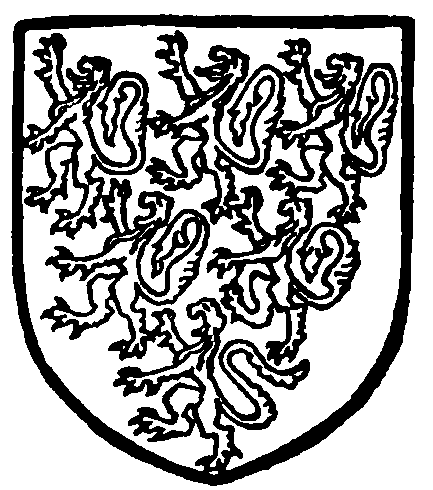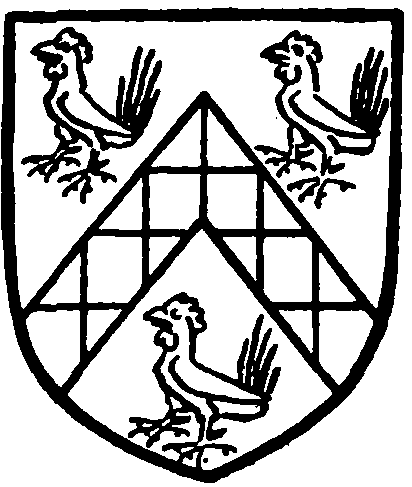Pages 510-511
A History of the County of Hampshire: Volume 4. Originally published by Victoria County History, London, 1911.
This free content was digitised by double rekeying. All rights reserved.
In this section
SHERFIELD ENGLISH
Sirefelle (xi cent.); Shirefelde (xiii cent.); Shyrfeld, Sherefeld Englysshe (xv cent.); Shervill (xvi cent.).
The parish of Sherfield English lies in a valley on the Wiltshire border and contains nearly 1,848 acres of land, of which 987 acres are arable, 345¼ permanent grass and 431¾ woodland. (fn. 1)
The village is in the south of the parish on the main road from Salisbury to Romsey. The manorhouse has been pulled down in modern times, but two brick cottages in the lane near the site of the old church mark the spot where the entrance gates once stood.
Birchwood, from which 'a plot of land not exceeding nine acres' was included in the sale of the manor to John Ingram Lockhart in 1785, (fn. 2) is in the southeast of the parish, while in the extreme south is Sherfield Mill, probably on the site of the mill mentioned in Domesday Book. (fn. 3)
The common lands known as Sherfield Warren were inclosed in 1810. (fn. 4)
The soil is loam, the subsoil sand and gravel; but there are several old chalk pits in the northern part of the parish. The chief crops are wheat, barley and oats.
Manor
The manor of SHERFIELD ENGLISH which Edric held in the reign of Edward the Confessor belonged after the Conquest to Hugh de Port, (fn. 5) with whose successors the St. Johns the overlordship continued until the end of the 15 th century. (fn. 6)
In 1166 Richard de Anesia held the manor as one knight's fee of John de Port, (fn. 7) while at the beginning of the 13th century a Robert de Anesia was holding the same of the old feoffment of Richard de Anesia of Robert de St. John. (fn. 8) It is uncertain at what date the Engleys family first became tenants of the manor, but Gilbert l'Engleys held lands in the neighbourhood as early as 1254, in which year he was fined for wasting his wood in Melchet Forest. (fn. 9) Richard l'Engleys, who was coroner in the county of Southampton and died in 1309, (fn. 10) seems to have succeeded to the estate, for 'a knight's fee in Sherfield formerly held by Richard l'Engleys' is mentioned in documents of the 14th century. (fn. 11) Aline la Engleys, who was probably Richard's widow, was seised of the manor in 1316 (fn. 12); she was succeeded before 1329 by John l'Engleys, (fn. 13) who was afterwards knighted and died before 1358, leaving a son and heir Richard. (fn. 14)
Sherfield had, however, apparently been settled on Joan sister of Richard and wife of Nicholas Woodlock, (fn. 15) who in 1359 joined with her in granting a life-interest in the manor to her mother Alice and her second husband, Robert Gerberd. (fn. 16) In 1369 Joan obtained a quitclaim of half the manor from her niece Margaret, (fn. 17) daughter and heir of Richard l'Engleys and then wife of Philip Dauntsey. (fn. 18) Thomas Woodlock was grandson and heir of Joan, (fn. 19) but only obtained Sherfield after the death of his mother Eleanor, on whom the manor had apparently been settled for life. (fn. 20) Thomas apparently left no issue, for in 1428 the manor was in the possession of Thomas Ringwood, as husband of Joan Bayford, a distant kinswoman and heir of Thomas Woodlock. (fn. 21)

L'Engleys. Sable six lions argent.
Charles Ringwood, probably grandson or great-grandson of Thomas, died seised of the manor in 1488, leaving a son and heir John, then two years old. (fn. 22) This John was twice married, and was succeeded at his death in 1544 (fn. 23) by his second wife Isabel, upon whom he had settled the manor for life (fn. 24) with reversion to his son and heir Charles. She afterwards married Christopher Willoughby, and a suit was then brought against her in Chancery by Henry son and heir of her stepson Charles, (fn. 25) and Elizabeth the widow of Anthony Ringwood, probably another stepson. (fn. 26) The plaintiffs did not, however, agree in their statements, for Henry denied that a conveyance had ever been made to Isabel, (fn. 27) while Elizabeth stated that her late husband Anthony Ringwood had bequeathed to her his interest in a lease which had been conveyed to him by John Ringwood the younger, (fn. 28) to whom Isabel had let the estate. (fn. 29) The case was decided in favour of the Willoughbys, and the manor was accordingly released to Isabel and her husband in 1566. (fn. 30)

Ringwood. Argent a cheveron checkered or and sable befween three moor-cocks in their proper colours.
In 1567 Henry son of Charles Ringwood, to whom the reversion of the manor belonged after the death of Isabel, sold his right to Lionel Tichborne, (fn. 31) who died in the lifetime of Isabel Willoughby, leaving his son Roger as his heir. (fn. 32) Roger died seised of the manor in 1620, (fn. 33) and was succeeded by his brother Michael, who sold the estate to Bartholomew Smith in 1629. (fn. 34) The Tichbornes, however, continued to hold the manor on lease from the Smiths, and in 1651 Bartholomew, who was probably the son of the purchaser, complained that his estate had been sequestered for the recusancy of the widow of the lessee, Michael Tichborne. (fn. 35) He therefore petitioned 'that he might not suffer for the crime of his tenant and that the sequestration might be discharged.' (fn. 36) The petition was at first considered, (fn. 37) but was eventually disregarded, the Parliamentary Commissioners having discovered that Bartholomew was himself a recusant. (fn. 38)
James, the elder son of Bartholomew Smith, joined a religious order in 1685, and the estate passed to his brother Bartholomew, whose daughter Anastasia married William Sheldon. (fn. 39) Their grandson, Edward Sheldon, sold Sherfield English in 1785 to John Ingram Lockhart, (fn. 40) whose family remained in possession for the next hundred years. Maria, the daughter and heiress of James Lockhart, married John Smith of Ellingham Hall (co. Norf.) in 1828, (fn. 41) and their son, Mr. Henry Lockhart Smith, who succeeded to Sherfield English on his grandmother's death, was lord of the manor until 1 January 1903, (fn. 42) when he sold it to Louisa Lady Ashburton. (fn. 43) She died a month later, and the estate then passed to its present owner, her grandson, Lord Spencer Douglas Compton. (fn. 44)

Smith of Ellingham. Party bendwise indented or and azure with two mill-rind crosses counter-coloured.
Church
The church of LEONARD, built in 1903 by the late Lady Ashburton in memory of her only child, Mary Florence Marchioness of Northampton, who died in 1902, is on practically the same site as that built by the Rev. the Hon. F. Baring in 1858, but pulled down in 1902–3 on account of its insecurity. When the nave of the original church, which stood about a quarter of a mile north of the later site, was removed in 1859 two stone coffins were discovered and sold to Sir John Cope of Lockerley Hall, where they remain. (fn. 45) In 1907, when the chancel of this church was pulled down, the upper half of one of the coffin lids was found built into what had been the space of the chancel arch. (fn. 46) This lid and various other details figure in the modern church. The church is built of red brick with stone dressings in 15th-century style. It consists of a chancel, a central tower with transepts and a nave with north and south aisles and north porch.
In the vestry is a very richly carved early 17th-century communion table, with a line of balusters between the legs and on one end a shield with two lions rampant in chief, and in base two bars wavy. Preserved at the rectory is another communion table with plain chamfered legs. Four panels of linen pattern and a line of quatrefoils are also preserved in a door in the vestry. The altar rails and font cover are of 18th-century date. The pulpit has six panels, three bearing allegorical figures of 'Temperance,' 'Justice' and 'Charity,' and the others fanciful shields with helmets and foliage enrichment. On the south wall is a mural tablet to Mary Fortune (15 March 1697–8). At the rectory is a panelled octagonal font of late date removed from the old church.
The bells are eight in number and modern; they are contained in an octagonal stone bell turret which rises from the square central tower and has four flying buttresses from the angles. It is finished by a short leaded spire.
The church has one set of plated vessels, a chalice, paten, flagon and almsplate, dated 1752.
The earliest register book contains mixed entries 1640 to 1746; the second and partly parallel, 1693 to 1702 curiously combined with churchwardens' accounts; the third, baptisms and burials 1741 to 1811. A marriage book appears to be missing between 1702 and 1754, but from that date there is the usual printed copy with entries up to 1812.
Advowson
The advowson of Sherfield English belonged to the lords of the manor until the middle of the 17th century. (fn. 47) It was included by Michael Tichborne in the sale to Bartholomew Smith in 1629, (fn. 48) but seems to have become separated from the manor before 1666. (fn. 49) It was bought, apparently between 1737 (fn. 50) and 1769, by Robert Bristow, whose family exercised the right of presentation for about a hundred years. (fn. 51) In 1875 the living was in the gift of Louisa Lady Ashburton, (fn. 52) by whom the advowson was transferred in June 1902 to the Church Pastoral Aid Society, to whom the living now belongs. (fn. 53)
There are no endowed charities in the parish.


